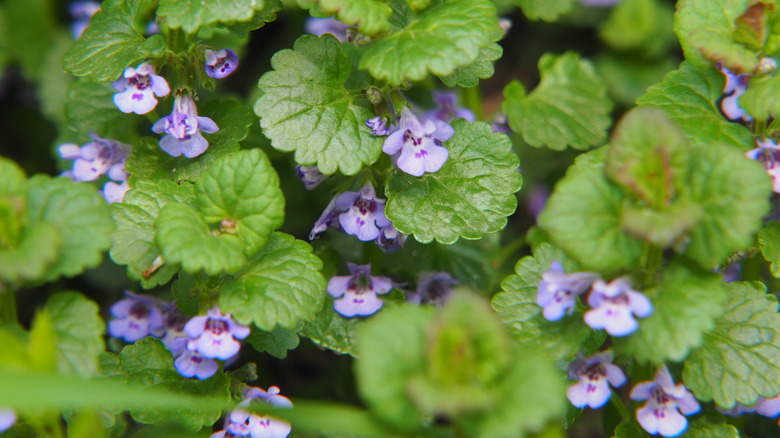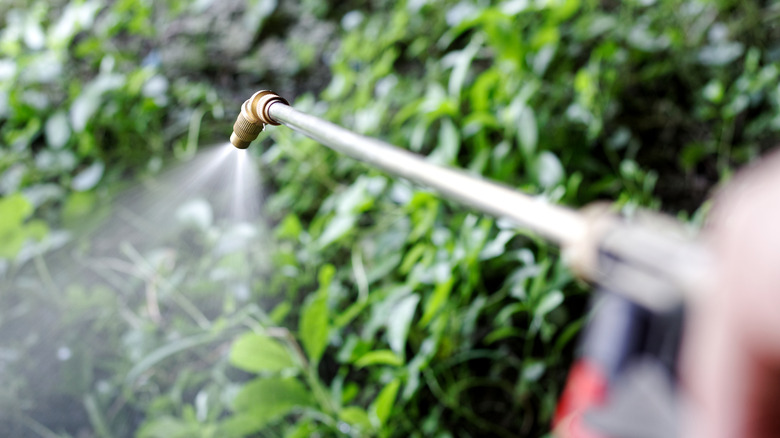How To Get Rid Of Creeping Charlie In Your Yard
Creeping Charlie is as menacing to homeowners' landscapes as its name suggests. The resilient weed has all the attributes of a hardened criminal, including a disguise of deceivingly pretty bluish-violet, funnel-shaped flowers and vibrant green, oval-shaped leaves with scalloped edges. At first glance, the perennial captivates with its delicate appearance, but don't be fooled; at its roots, creeping Charlie is a silent killer overtaking everything in its path with an aggressively invasive vine system. In order to get rid of creeping Charlie, you can apply chemical herbicides or fight back naturally by pulling or smothering the insidious weed.
Like many nefarious villains, creeping Charlie has a litany of aliases — Glechoma hederacea, ground ivy, gill-over-the-ground, alehoffs, and cat's foot. However, a weed by any other name is still a weed, and creeping Charlie is no exception. Introduced to North America in the 1800s by European settlers as an ornamental plant related to the mint family, creeping Charlie has proven to be more cunning than charming. Its ability to rapidly spread in moist, shady areas via its prolific square-shaped stems that grow wiry roots makes creeping Charlie an extreme nuisance for homeowners. You may innocently plant it as groundcover, but before you know it, creeping Charlie makes like its name and creeps like quicksand, carpeting open spaces and overwhelming your entire yard.
How to kill creeping Charlie with herbicide
Getting rid of severe infiltrations of creeping Charlie may require pulling out the poison. When going to battle against large patches of creeping Charlie, select a broadleaf herbicide with the active ingredients salt of dicamba or triclopyr. The former represses the weed's growth, but depending on how deep its roots are entangled with the fibrous roots of your turf grass, dicamba's effectiveness may be compromised. Still, the herbicide is no shrinking violet; even when applied directly to creeping Charlie, dicamba can vaporize and kill surrounding plants. Consequently, you should avoid using even minimal amounts of dicamba-based herbicides near vegetable gardens, fruit trees, and flowering plants. Moreover, protect yourself by donning gloves, a mask, and goggles before spraying.
As for triclopyr, it's designed to completely annihilate creeping Charlie from the root up, but spare the rest of your lawn. Still, it's a powerful toxin that poses health risks and should not be used to liberally treat expansive areas of weeds. Doing so can lead to triclopyr leeching into aquifers and waterways, potentially contaminating drinking water and harming wildlife. Take precautions prior to applying chemical herbicides containing triclopyr to your lawn and garden, including watching the weather. Don't treat creeping Charlie with chemicals if rain is forecasted within 24 hours of the application. Likewise, pick a day with little or no wind so the toxins don't transfer to your prized plants. Ideally, plan to get rid of creeping Charlie after the first frost and use its poisoned, dead roots as compost.
Natural ways to get rid of creeping Charlie
If you're wondering how to get rid of weeds in your garden like creeping Charlie minus the harsh chemicals, raise your hand, then put it to good use. Hand weeding is a viable option to eradicate creeping Charlie from your yard if the weeds are isolated to a small space or you can't use chemical killers because children or pets play nearby. Just remember it's vital to remove all of the roots and place them in a bag or bucket to avoid regrowth. For especially tough roots, soak the soil first, then use a spade to loosen the roots' grip.
Another eco-friendly way to get rid of creeping Charlie is to smother it with cardboard, newspaper, or a tarp. Regardless of the material you select, be sure it extends about 12 inches beyond the weed patch to guarantee complete stem and root coverage. Next, apply large rocks or bricks to hold the cover in place. The goal is to completely block the sun's rays from reaching the weeds. Depending on the size of the infestation, it could take two or more weeks for the suffocation method to work. You'll know the process is a success if after a week you notice some of the creeping Charlie is brown and withered. Once the weeds are dead and the area is cleared, consider filling the space with flowers that grow perfectly in shade.


